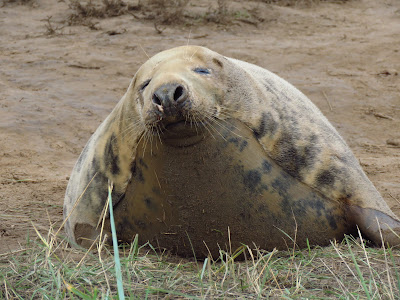I get there at 10:25 and park at the overflow car park (£4, but with portaloos) and walked across the field to the dunes. The eerie calls of the seals can be heard before you see them behind the dunes.
Skylarks chirp over and sing, there are so many about. The fog and mist present most of the drive is now gone and the sun is shining in long spells. I can't believe how mild it is. There are quite a few seals, not as many as in the peak season later in November, but enough to see a lot of behaviour happening.
The characters
To work out what's happening in the long, flat beach you need to be able to identify males (bulls) from females (cows). At the beginning it may be a bit tricky to tell them apart, but a bit of practice will help. In the photo above the bull is in the background and the cow in the foreground, illustrating their differences. The pups are quite obvious, they are much smaller, and when young they are covered on a thick coat of white or yellowish fur (below, a pup right next to the fence).
Bulls
Bulls are much larger than cows, with a thicker neck and usually darker, but as the seals often get covered in mud, colour might not always help. The bull's neck, especially in older individuals, is creased and their muzzles are larger and with a convex profile. A few bull portraits follow. I didn't witness any actual fights between males, just some chases and open mouthed threats, but many males had bloody necks from recent fights. Males slumber most of the time, but show interest in squabbling females. They snort or sneeze, but the most surprising noise is their thumping of the sand with their anterior body, which they lift of the ground and let fall a few times, a deep sound that you can't miss.
Cows
Cows are smaller have a slimmer neck and head than bulls. They appear paler, and can be very spotty.
Despite their smaller size, cows are very feisty and noisy, howling and squabbling with other cows that are too close to their pups and also with males that give them unwanted attention. The following photos are two females squabbling.
Pups
The younger pups (up to 2 weeks) are all white. Newborn pups can look quite skinny, but they quickly fatten up on the rich milk produced by their mums. At about two weeks they start moulting into their adult coat, and after the moult is complete they are weaned and they head to sea on their own.
An older pup starting to moult. The eye and face area start showing the definitive coat colour first.
Yawning pup showing its sharp teeth.
A resting pup.
This pup is likely to be a few hours old. Its umbilical cord hasn't detached yet and it has a strong yellow tinge.
Another young pup.
The plotMums and pups. Pregnant cows head to the safety of the beach to give birth.
This cow looked restless, going across the grass from one place to another and often raising her head and looking around. Maybe looking for a suitable spot to give birth?
Pup and mum.
A cow approaches a pup and sniffs it. Cows become imprinted on their pups smell and call after birth and respond and feed only to their pups.
The pups put on weight very quickly, gorging on a milk that is more than 50% fat. They call their mums when they are hungry and the mums often engage in scratching bouts with them.
Cows and bulls. Cows become receptive a couple of weeks after pupping, and that's the reason bulls are on the beach. They are just waiting, next to the females, for them to be receptive. 'Just waiting' is a massive understatement: bulls are often fighting each other for the positions in the beach next to females: their bloodied necks are witness to this. Older individuals are the ones that are going to get most matings, while the younger bulls are quite mobile, searching for mating opportunities on the edges of the beach, or occasionally challenging a resident bull. Adults won't feed for the few weeks they are on the beach, and as soon as the females are mated, they will head back to sea. I saw no matings, but some females approached slumbering males, sniffing them.
Scavengers
The beach has many scavengers about. They are looking for afterbirths (placentas) near the newborn seals. They won't turn their eye to the occasional dead pup too. Magpies, Carrion Crows (above), Great Black-backed gulls and Herring Gulls were about today. As I scanned the marsh for birds I spotted a Hooded Crow! I was pretty excited - it was my first English Hooded Crow. I tried to convey my excitement to the other seal watchers but to no avail, there was no enthusiasm whatsoever!
Magpie also walking along seals.
The Hooded Crow.
Hooded Crow and seal.
Great Black-back gull.
The waves break and roar in the distance as the tide comes in. A few seals near the breakers.
I walk to the end of the seal area and look back. A colourful line of people behind the fence separating the seal from the onlookers.
On the saltmarsh, near the high tide a large flock of Brent Goose feeding, with a few shelduck.































No comments:
Post a Comment